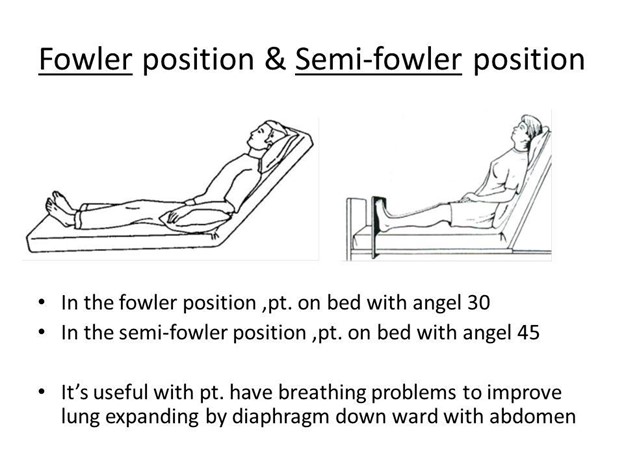A patient is having trouble defecating into a bed pan while lying in bed. Which action by the nurse would assist the patient in having a successful bowel movement?
Administering laxatives to the patient
Preparing to administer a cleansing enema
Withholding narcotic pain medication for at least 2 hours until the patient had a bowel movement successfully.
Raising the head of the bed to a semi or high Fowlers position
The Correct Answer is D
Raising the head of the bed to a semi or high Fowler's position (sitting up at a 30-45-degree angle) can assist the patient in having a successful bowel movement while using a bedpan. This position helps to facilitate gravity, making it easier for the patient to bear down and evacuate their bowels.

Administering laxatives to the patient in (option A) is incorrect because laxatives are medications that help promote bowel movements. While they may be used in some cases of constipation, they might not be the immediate solution for a patient having difficulty using a bedpan.
Preparing to administer a cleansing enema in (option B) is incorrect because Enemas involve introducing liquid into the rectum to stimulate bowel movements. They are typically used for more severe cases of constipation or as part of a bowel preparation before certain medical procedures. For a patient who is simply having trouble using a bedpan while lying in bed, an enema may not be necessary or appropriate at this time.
Withholding narcotic pain medication for at least 2 hours until the patient had a bowel movement successfully in (option C) is incorrect because, while some pain medications, particularly opioids, can cause constipation as a side effect, withholding pain medication solely for this purpose may not be appropriate or safe. Pain management is essential for patient comfort and recovery, and the nurse should find other interventions to assist with bowel movements while maintaining appropriate pain control.
Nursing Test Bank
Naxlex Comprehensive Predictor Exams
Related Questions
Correct Answer is A
Explanation
The faceplate, also known as the wafer or barrier, of an ostomy appliance should typically be changed every 3 to 5 days. This timeframe allows for regular maintenance of the stoma and surrounding skin, ensuring proper hygiene and minimizing the risk of skin irritation or infection. However, it's important to note that individual circumstances may vary, and the frequency of faceplate changes can be adjusted based on the patient's specific needs, the type of ostomy, and the condition of the skin. Regular assessment of the stoma and peristomal skin is essential to determine the optimal timing for faceplate changes.
Correct Answer is C
Explanation
Using just any solution that is convenient for irrigating and cleaning an ostomy stoma is not safe and can lead to complications. It is essential to use a specific solution recommended by the healthcare provider for ostomy irrigation. Typically, a healthcare professional will prescribe a sterile irrigation solution that is appropriate for use with the ostomy, and it's crucial to follow their instructions.
Options A, B, and D are all do not indicate a need for further instruction:
In option A, "I should never attempt to reach into my stoma to remove fecal material." - This is a statement that does not require further instruction because reaching into the stoma can cause damage and should be avoided.
In option B, "Using warm enema will reduce cramping and discomfort during the procedure." - This is a statement that does not require further instructions because using a warm solution can help relax the muscles and reduce discomfort during ostomy irrigation.
In option D, "Sitting on the toilet lets the ostomy bag and irritant drain into the toilet bowl." - This is a statement that does not require further instructions because sitting on the toilet allows for easy drainage of both the ostomy bag and the irritant into the toilet bowl during the irrigation process.
Whether you are a student looking to ace your exams or a practicing nurse seeking to enhance your expertise , our nursing education contents will empower you with the confidence and competence to make a difference in the lives of patients and become a respected leader in the healthcare field.
Visit Naxlex, invest in your future and unlock endless possibilities with our unparalleled nursing education contents today
Report Wrong Answer on the Current Question
Do you disagree with the answer? If yes, what is your expected answer? Explain.
Kindly be descriptive with the issue you are facing.
